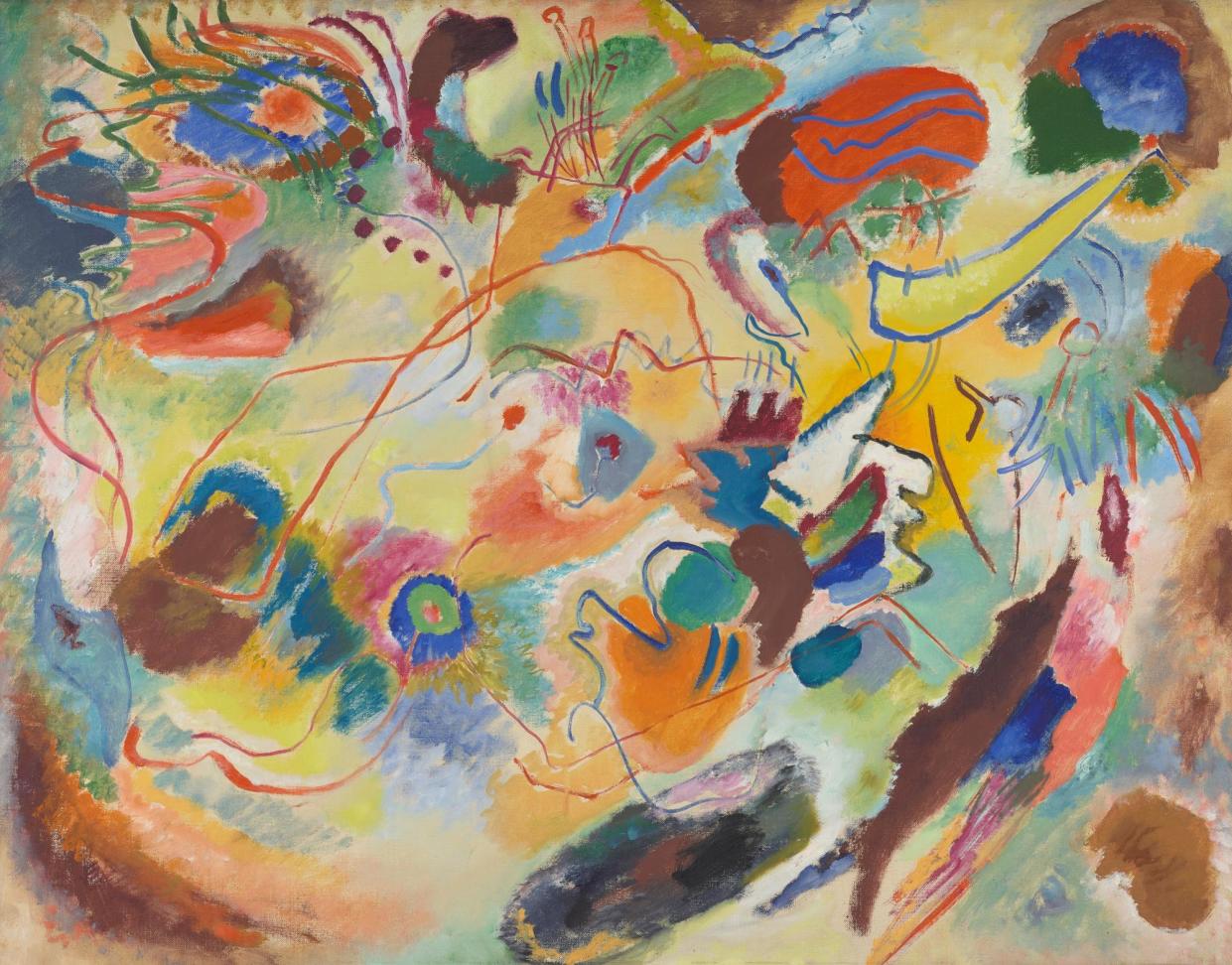Free expressionism: a fresh look at revolutionary art collective the Blue Rider

The story of expressionist art, with its bold colours, off-kilter figures and presciently unsettling atmosphere of pre-first world war Germany, is usually told through the prism of two groups of artists: Die Brücke (The Bridge), operating out of Dresden and featuring Ernst Ludwig Kirchner and Erich Heckel; and Der Blaue Reiter (the Blue Rider) in Munich, which was led by Wassily Kandinsky and Franz Marc. But a new exhibition at London’s Tate Modern focusing on the Blue Rider – the first major show on the subject in the UK for more than 60 years – explicitly seeks to both expand and complicate that established narrative.
A clue to the show’s thesis comes in its title, Expressionists: Kandinsky, Münter and the Blue Rider. Gabriele Münter was a wealthy photographer, painter and partner of Kandinsky who had undertaken part of her art education and development in the United States. Her elevation above Marc in the Blue Rider story not only sees a woman placed at the centre of this remarkable artistic enterprise, but also serves to expand it beyond the borders of Germany and to celebrate a genuinely international experiment.
Related: Expressionism at Lacma: bringing order to a time of aesthetic flailing
“From the beginning the Blue Rider was less a strict group than a broad-church community of artists,” explains Tate curator Natalia Sidlina. “They were transnational and were linked through various friendships and relationships – intimate, unconventional and professional – as well as through artistic collaborations, and shared quests and beliefs around spiritual and social renewal. And at the core of these webs of relationships were Kandinsky and Münter.”
In Munich salons – and even more so at Münter’s rural Bavarian home in Murnau – she and Kandinsky created a space for intellectual exchange where artists, literary critics, composers – Arnold Schoenberg was a friend – and performers could mingle with academics, scientists and many others. In 1911 and 1912 the group staged two influential exhibitions and published an ambitiously experimental almanac that included multi-disciplinary art as well as editorial and criticism.
Münter was in effect exercising the traditionally male privilege of patronage, and into this orbit came misfits and marginalised artists from all over Europe. The relatively liberal and permissive atmosphere of Munich allowed innovative ways of living, exemplified by the androgynous dancer and choreographer Alexander Sakharoff and the relationship between Russian artist Marianne von Werefkin, who declared: “I am not a man, I am not a woman, I am I”, and the painter Alexej Jawlensky. Painters such as Marc, Paul Klee and August Macke were joined as equals by female artists including Elisabeth Epstein and Sonia Delaunay. About 40% of the paintings in the new show will be by female artists – some of which have not been seen before in the UK – alongside sound, performance and archival content.
Related: Ofili: the blue period
The Blue Rider effectively dispersed in the face of the first world war, but Sidlina says its legacy and example speaks with remarkable clarity to many modern artists today: “The challenges and issues they faced feel very familiar: the trauma of war, the migrant experience, fluid identities, ethnic and gender chauvinisms. Their response was friendship and solidarity of spirit as well as experimentation and radicalism. They sought and found the much-needed support of a community at a time when it was needed. It is an idea and a lesson that continues to resonate.”
Four more images from the exhibition
Marianne von Werefkin – The Dancer, Alexander Sacharoff, 1909
Sacharoff was known for disturbing gender norms through his costumes and groundbreaking free movement performances. This portrait offers a challenge to the male gaze in that it is a woman portraying a man portraying Salome on stage. It is an entirely empowering image that not only gives Sacharoff the right to explore his identity, but for Werefkin to explore hers too.
Gabriele Münter – Kandinsky and Erma Bossi at the Table, 1912
Here Münter turns the tables on the male-dominated art world. She places Kandinsky, who may well be mansplaining to fellow artist Bossi, in a traditionally feminine interior space. The confident projected male persona is further undercut both by Kandinsky’s childlike Bavarian shorts and Bossi’s authoritative teacherly outfit.
Elisabeth Epstein – Self-Portrait, 1911
Epstein, at some personal cost, left her husband and young son to pursue her life as an artist. She was instrumental in bridging the artistic and creative communities of Paris and Munich, and here she depicts herself as a mature, independent woman unapologetically breaking from social convention and imposing her persona on the life choices she has made.
Franz Marc – In the Rain, 1912
This hidden portrait of Marc, his partner Maria and – calmest of all in the face of a dramatic deluge – their dog Rossi illustrates Marc’s awareness of the avant garde’s command of cubism and futurism.
Wassily Kandinsky – Study for Composition VII, 1913 (main image)
Kandinsky’s work would prove hugely influential on the direction of 20th-century art with this image becoming particularly important in terms of post-second world war art theory and the rise of abstraction.
Expressionists: Kandinsky, Münter and the Blue Rider is at Tate Modern, London, 25 April to 20 October.

 Yahoo News
Yahoo News 
